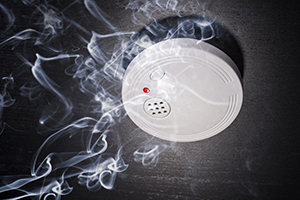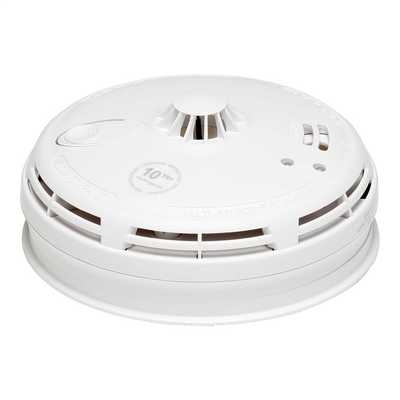How Do You Know if Smoke Detector Has Carbon Monoxide as Well
The Deviation Betwixt Fume, Estrus And Carbon Monoxide Detectors

The statistics regarding fires in the Uk make for rather sobering and frightening reading. Every year in the UK, fire services are called out to more than 270,000 fires including over 40,000 residential fire-related incidents.
These blazes result in more 11,000 injuries and 400 fatalities. The sad fact is that many of the injuries and deaths which occur because of domestic fires could have been prevented by the presence of an early alert system.
Inquiry has revealed that householders are four times as probable to be killed past fire in a house that does not have an alarm when compared to a property that has one installed.
Although deaths from carbon monoxide poisoning are non as common as those caused by fire, the number of fatalities is still too high and these deaths are easily preventable.
Thankfully, it seems that many householders are starting to fully realise the potential dangers posed past not having detector alarms for fire, smoke and carbon monoxide fitted in their properties.
Before installing whatever of these detector systems in a property, it is appropriate to know exactly what each alarm does, where it should be placed and any laws which govern their use in landlord-owned properties and new-builds.
Carbon Monoxide Detectors

Carbon monoxide (CO) poisoning is known as the silent killer for a reason. The gas is colourless, odourless and tasteless. It is impossible to tell if a gas appliance in a property is leaking carbon monoxide without the assist of a detector.
People practice not know they are suffering from CO poisoning until it is also late.
Even if the poisoning is non at a high enough level to kill, information technology tin still cause animate problems for the rest of a person'southward life.
Gas appliances which do not fire fuel properly produce excess carbon monoxide, which is then permit loose into the temper. Audible carbon monoxide alarms observe the presence of the backlog CO and warn residents appropriately.
Although they are simple to install, carbon monoxide detectors should exist fitted as per the manufacturer's instructions and serviced appropriately to avoid whatever potential warranty issues.
If a unmarried alarm is being installed, it should be placed near to the main sleeping areas to ensure it tin can exist heard by occupants if it goes off. When more than i alarm is to be fitted, ane should be placed about sleeping areas while others should be placed near to potential sources of carbon monoxide.
If fitted on a ceiling, the alarm should ideally be at least 300mm away from low-cal fittings or walls.
Smoke and Fire Detectors

The most common type of detector is that used to notice smoke and burn down.
Since 1992, building regulations in the UK accept required each new-build to accept at least ane smoke alarm to be wired to the mains.
The biggest advantage to mains-powered alarms is that there is no demand to worry about battery life. However, residents need to be fabricated aware that even mains-powered detectors only accept a certain shelf life.
Information technology is recommended that all mains-powered alarms are replaced every ten years to ensure their working integrity.
There are four primary types of smoke and fire detectors:
Ionised Smoke Alarms
Ionisation, optical, heat and combined. Of the iv, ionisation alarms are the to the lowest degree expensive. They are very sensitive at detecting smoke from fast-burning flames only less effective with slow-burning fires.
Optical Smoke Alarms
Optical alarms may be more expensive only are far more adept at detecting large particles of smoke from boring-burning fires. Unlike ionisation models, optical alarms can exist installed well-nigh kitchens, as they are less likely to exist triggered past fume from burnt food.
Oestrus Alarms
If a householder wants an alarm fitted in their kitchen, the best type for these situations is the heat alert. This blazon of detector is not sensitive to smoke and works by recognising a significant ascent in temperature instead, such as that caused by a fire.
Combined Detectors
Combined alarms are simply combinations of detectors, such as ionisation and optical models.
The All-time Combination of Detectors
For maximum protection, information technology is advised that each room in a property should have a fume detector installed. However, this is not ever practical, and so a skillful rule of thumb to go by is to at least ensure that each floor of a property has an alarm fitted. In these cases, a combination of ionisation and optical alarms works best.
As with kitchens, bathrooms should only exist fitted with heat alarms. Whatsoever other blazon of detector will exist triggered past the presence of steam, leading to constant false alerts.
In landlord-owned properties where at that place are a number of dissimilar tenants, fire detection systems which are capable of waking sleeping people accept to exist in place by constabulary. This usually requires the presence of interlinked mains-powered smoke or heat alarms that are fitted with a battery dorsum-upward.
The plumbing equipment of alarms which find fume, burn and carbon monoxide is a simple process and could lead to precious lives being saved; in that location actually is no alibi for not fitting them in backdrop!
Source: https://www.cef.co.uk/blog/1596-the-difference-between-smoke-heat-and-carbon-monoxide-detectors
0 Response to "How Do You Know if Smoke Detector Has Carbon Monoxide as Well"
Postar um comentário